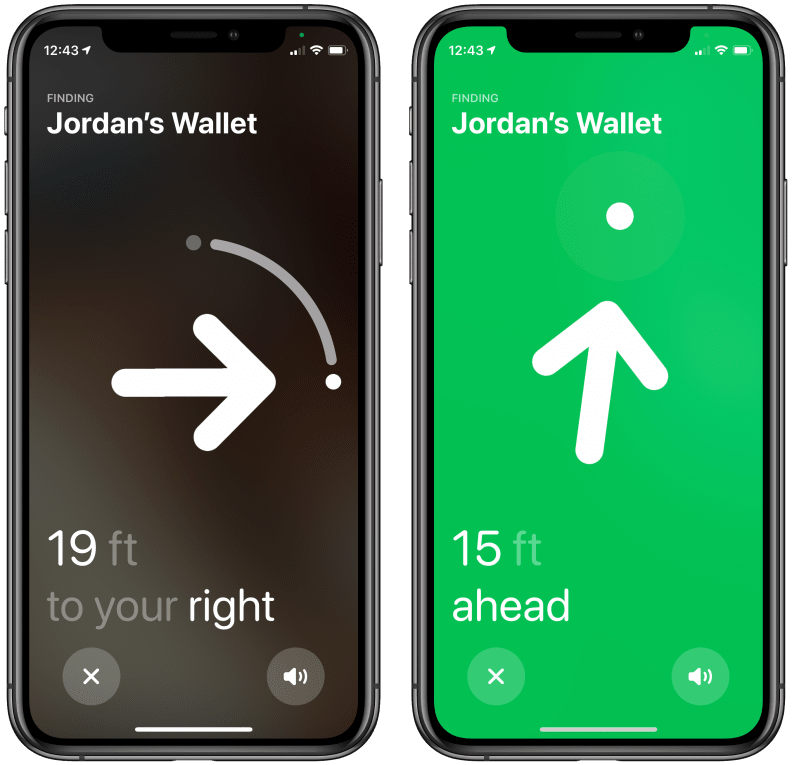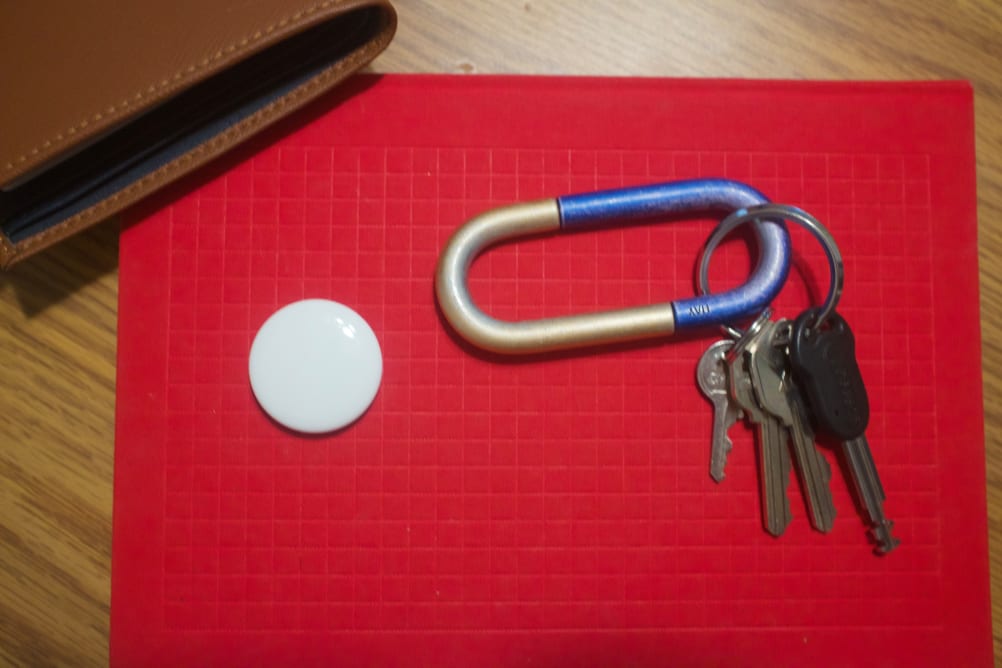Pros
-
Great location accuracy
-
Easy to set up and use
-
Replaceable battery
Cons
-
No Android support
-
Speaker is too quiet
-
Not ideal for pet tracking
That’s where Apple’s new AirTag comes into play. For those items you tend to lose while you’re out and about, the company’s tiny electronic tracker uses a mesh network of Apple devices to give you a near real-time update of where your AirTag—and the knickknack it’s accompanying—are. Its painless setup, $30 starting price, and accurate tracking make it a worthwhile investment for those who routinely visit the Lost and Found, as long as you’re mindful of the privacy risks involved with carrying an always-on tracker.
This review has been updated to reflect Apple's firmware update designed to address privacy concerns.
Breezy setup
The AirTag is only slightly larger than a typical bottle cap, and the white top can easily be removed to replace the CR2032 battery inside, though Apple says the battery should last a bit over a year so you shouldn’t have to worry too much. It’s quick and easy to set up, too, requiring only that you pick out a name for your designated item (and perhaps a cute emoji if that's your jam). There are even a few pre-populated suggestions for items to track—handbag, bike, umbrella—but you're essentially only limited by the AirTag's inability to latch onto whatever you're hoping to keep an eye on (more on that later). For this review, I attached the tracker to my dog Behr's collar, to see if I'd be able to track him down should he wander too far on our next adventure.
Once you've given your AirTag a unique name and tied it to your Apple ID, you can peep its location any time in the Find My app on your iPhone or iPad—there’s no support for Android. Within the app, you have a few other options for hunting down your AirTag and its accomplice. If you're just unsure of where you left something in your apartment, you can either trigger a sound that'll play from the AirTag's tiny speaker, or use the handy "Find" button that will turn your phone into a compass that directs you straight to the missing item.
You can also remove the AirTag from your account, or rename it, with just a few taps, so its purpose can quickly be reassigned as your needs change. If you lose track of it, your only other option is to place the AirTag into "Lost Mode," which locks your AirTag to your Apple ID (nobody can try to reset it and use it as their own), notifies you when the device's location becomes available, and allows you to leave a message and phone number for whoever finds it.
A silent tracker
When you've lost one of your essentials, it's best to hunt it down as quickly as possible. Apple's AirTags lend a helping hand through near real-time tracking that works well both within your home, and out in the real world where your items may fall behind.

If your missing item is close-by, you can track it down using the "Find" feature in the Find My app that turns your phone into an item-sniffing compass.
Can't find your AirTag-attached wallet? Just tap the "Find" button in the Find My app, which triggers Precision Tracking (so long as you have an iPhone 11 or newer), and points an arrow in the direction of your AirTag so you don't have to spend a bunch of time shuffling about your room to find the spot. If that doesn't work, you can also play the chime that'll emit from the tag's speaker. The noise is loud enough to hear in most indoor situations, even when stuffed inside a thick wallet, so as long as your home isn't too noisy this method should work.
That's not so when you're trying to find something outside, though. Once I attached the AirTag to my dog Behr's collar using a generous amount of tape—Apple doesn't provide any way to attach the tags to your items, but there's plenty of accessories they'll happily sell you—we set out on a walk to the beach to see if I could keep track of him when he ventured too far. He wasn't a fan of the sound when I tested it in the apartment, but he quickly got over that. Just be sure to test the noise with your pet before latching this onto their collar.
Once we got to the dog beach, I let him drift off a bit as we played fetch, and tried to play the lost sound on the AirTag, but I couldn't hear it through all the wind and chatter when I was close enough to trigger it. That's not a knock on Apple, the speaker would need to be pretty powerful to pierce through the louder sounds of the public, but it's important to know which tracking method you're going to rely on to hunt down whatever you've slapped your AirTag onto.

The AirTag doesn't provide true real-time updates of its location, but it gets pretty close.
Luckily, for times when an audible ping simply won't do, the frequent updates work impressively well. When Behr wandered too far down the path, I could easily see where he veered off to and follow his dot on the map until he was within eyesight.
Privacy threat
That near-constant tracking works well for a dog who likes to say hello to every friendly face he passes by, but it's a bit more troubling for its ability to track other people. I asked my girlfriend to take the AirTag with her for a few hours as she ran errands, so we could test its privacy notifications and see how frequently it updates.
Over the course of a few hours, I could tell when she left a restaurant, when she got to the grocery store (as well as a rough guess as to where in the store she was), and when she got to our favorite local bakery to surprise me with a few treats. In that time, she didn't hear any sounds emit from the AirTag, nor did her phone receive any notifications, despite running iOS 14.5. That’s because the tags don’t ping unsuspecting users until the tracker’s been near their device for up to three days. That’s changing, according to CNET, as Apple plans change that duration from three days to between 8 and 24 hours. CNET also reports that Apple is planning on releasing an Android app that will notify users of unwanted nearby AirTags; we'll test that when it becomes available.
For now, if you’re using this to track personal items like your wallet, bike helmet, or water bottle, that won’t really present an issue. On the other hand, if you're going to attach an AirTag to something that will frequently be in someone else's hands, such as your dog's collar or your household grocery tote, there's more Apple could do here to prevent unwanted tracking. The sound that emits from the AirTag when it's too far from your iPhone, as well as the notification for post-iOS 14.5 devices, should trigger sooner than they do—as it stands, the time between departure and notification leaves plenty of time for an unsuspecting person to be tracked.
Endless possibilities (for a price)
The AirTag’s power lies in its simplicity: a few minutes after popping it out of the box, you can plop the AirTag alongside your most prized possessions with confidence that, should you lose it, getting it back won’t be too much trouble. The problem with that simplicity is that it trumps the AirTag’s usability as a tracker. Without any way to attach the AirTag to, say, your suitcase or favorite jacket, you’re left with two options: let it hang loose in a pocket and hope it doesn’t slip out, or purchase an accessory that will easily latch onto whatever you want to keep an eye on.

Apple doesn't provide any accessories to attach the AirTags with in the box, so you'll have to get creative if you don't want to purchase any additional hardware.
Those accessories vary in price and utility, from $13 for a keyring holder from Belkin or $35 for a leather option from Apple, to $39 for a leather loop suitable for your luggage. There’s even a $24 collar attachment to keep track of your pets. That flexibility allows you to do a lot with the AirTag, but the lack of any basic accessories in the box, like say a simple luggage tag or keyring, would've allowed the product to shine on its own, rather than relying on additional purchases to get the full experience.
How it stacks up
While we haven’t directly compared the AirTag to other trackers such as Tile’s Pro and Mate, or Samsung’s SmartThings Tracker, the AirTags have a competitive edge thanks to a mesh network of Apple devices it uses for more accurate tracking—as long as someone with an Apple device crosses by your tracker you’ll have a good idea of where it’s located. On the other hand, Tile’s trackers rely on having someone else with the Tile app installed on their phone to update your item’s location.
That caveat aside, it’s worth noting that Tile offers its trackers in packs of two, not just single or four packs, and a four pack of the Tile Mate is $30 cheaper than Apple’s $100 counterpart. While that’s probably not enough to sway you one way or the other, it does end up being a bit cheaper to grab two Tiles than two AirTags.
Should you buy it?
Yes, but be mindful of what you’re tracking.
It’s hard to put a price on finding a valuable or important item you thought you’d lost, but $30 for a single tag and $100 for a pack of four is an incredible bargain for the precise tracking AirTags offer. That said, the accuracy of that tracking poses a serious risk in the wrong hands, so you have to be sure that if you’re letting someone else take hold of an item with an associated AirTag, they’re aware of it, because at that point you’re tracking them as much as you are your beloved item.
It's also important to note that while Apple has added some features to combat against using AirTags for stalking, those measures don't go far enough. The delayed notification sound, and its weak noise level, don't do enough to notify people of their tracking until the damage may have already been done. Even Apple's notification for unidentified AirTags—which didn't even work in our testing—is only available to iOS devices running 14.5 or later, leaving Android users completely in the dust if they miss the little ping emitting from the AirTag's speaker.
It’s unfortunate that the AirTags themselves have no way to attach to an item—something provided by both Samsung and Tile’s own trackers—rendering them fairly useless without additional purchases. That does offer a little more wiggle room in terms of customizations, but you’ll have to factor the cost of accessories into your budget in addition to the cost of the AirTags.
As long as you’ve squared away any potential privacy issues, and you’ve accepted the costs of any additional accessories, Apple AirTags are an excellent way to ensure some peace of mind that if your items fall astray, you won’t have much trouble getting them back. Apple’s given the AirTag enough tracking capabilities to ensure you’ll be able to find what you need, and it’s all done in a clever and elegant package that doesn’t take up too much space.
Meet the tester

Jordan McMahon
Staff Writer, Electronics
Jordan has been writing about and reviewing technology since 2017, with products ranging from tablets and apps to fanny packs and home office gear.
Checking our work.
Our team is here to help you buy the best stuff and love what you own. Our writers, editors, and experts obsess over the products we cover to make sure you're confident and satisfied. Have a different opinion about something we recommend? Email us and we'll compare notes.
Shoot us an email

